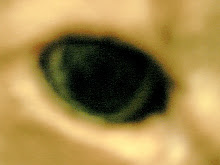"I don't know what I like; I just know art." Okay, he didn't say that, but the San Francisco Chronicle art critic did say:
This particular Chronicle critique, which I had not cared to read but came back to because of the furor it generated, was a flat denunciation of the new Chihuly exhibit at SF's de Young Museum.
So, if you've carved up a block of soap or taken chalk to your driveway or started humming a tune no one has ever heard, call it your art. It still may be unpopular, but if you made it from your heart and mind and soul and say it is so, it is art.
...In today's culture, people need not merely critics to tell them what art is, but also artists, curators, art historians, art dealers, collectors - and the viewers' own education and sensibility...It is this very attitude that crushes budding artistic spirits. A child makes something to help her understand an experience or to express an idea for which she has no words or simply to create something from her mind which no one has ever seen before. Could be art, but how will she know if there are no "critics, artists, curators, art historians, art dealers, [and] collectors" to tell her so, or more likely not? If we need all these experts to tell us what art is, who would dare encourage that expressive child to believe that she made any?
...Most of us would prefer to believe that "art" is a quality inherent in or infused in certain things, but the history of modern art, and of its enveloping social reality, has left us in a much more complex and ambiguous position. Those who refuse to acknowledge this are the very dupes that the culture industry banks on...Well, he started a little better here, if demeaningly, and then spiraled into exclusionist jargon and plain insult. If art can only be authentic in the context of art history, how were those historical pieces validated themselves? At some point, someone made a sculpture, did a dance, painted on a wall and knew it was art. Someone else saw it and agreed. Somebody else looked at it and said, "Horse feathers!" (or something to that effect). Art, like beauty, is in the eye of the beholder... and the creator. Some is just more popular than most and only the artist knows if it was art when he made it. Now, if a piece is created without heart and mind and soul, it isn't art. But if a stranger experiences it, is moved by it, finds it worthy of consideration, it becomes art. Like the Velveteen Rabbit, cloth and fluff and glass eyes from a factory, experienced by a small boy he became real.
This particular Chronicle critique, which I had not cared to read but came back to because of the furor it generated, was a flat denunciation of the new Chihuly exhibit at SF's de Young Museum.
...Political philosopher Hannah Arendt defined artworks as "thought things," that is, things that materialize thought, things to be thought about and, in rare cases, things to help us think...I propose what is failing in this whole evaluation is Baker's narrow ability to "materialize thought" for himself. The human mind is a wondrous thing. It can be fertile, stimulated to great thinking by almost anything. Or it can be dry, locked down, and fearful of having a thought which doesn't meld with what the experts currently extol.
...Perhaps dreamy color, glossy surfaces and flamboyant design - the signal qualities of Chihuly's work - should be enough. But in a culture where only intellectual content still distinguishes art from knickknacks, they are not...
So, if you've carved up a block of soap or taken chalk to your driveway or started humming a tune no one has ever heard, call it your art. It still may be unpopular, but if you made it from your heart and mind and soul and say it is so, it is art.

